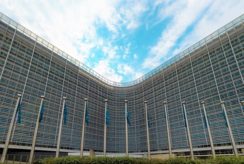The Internet: a wealth of opportunities or a source of threats?
Since its inception in the early 1990s, the internet has come a long way. Little by little, thanks to increasingly fast and disruptive technological developments, access to internet has become simpler and more omnipresent. People are increasingly accustomed to using it in their everyday life, to the extent that they now rely on it for an infinite array of services, ranging from eCommerce to home banking. Ultimately, the ground-breaking power of the internet, with its ability to exponentially connect people from all over the world and enable them to almost seamlessly share information with each other, led to unprecedented opportunities in terms of socio-economic growth and empowerment.
It soon became apparent, however, that the many “wonders” brought about by the internet also had a dark side, for instance, by increasing anonymity and the depersonalisation of the users that hide behind the screen. This proved to be a fertile ground for the emergence of new forms of illegal activity, among which is the circulation and spreading of child sex abuse material (CSAM). This in turn opened up the way to new and diversified forms of child sex abuse online. As a response, the first hotlines in the world dealing with CSAM were established in Holland, Norway and the United Kingdom back in 1995/96, followed closely by the United States in 1998. In 1999, the International Association of Internet Hotlines (INHOPE) was created to raise awareness on the topic and help promote the establishment of hotlines in different countries. Today, INHOPE, with funding from the European Commission, connects and supports a global network of 46 member hotlines.
Evolving technologies for more sophisticated cybercrimes
The rapid evolution of technology, however, keeps bringing about new emerging threats to the safety of children. Today everyone can “connect” through smartphones, tablets or even watches and it has never been easier to share images or stream content online. Further to this, it should be highlighted that children now constitute a major group of content creators or users (in 2017, one in three internet users around the world was under 18). In this new era dominated by the interactive web – sometimes referred to as Web 2.0 and social media – it is clear that the work of the hotlines needs to continuously evolve to be able to keep pace with the latest technological developments, and thus be effective in protecting children and having illegal online material quickly removed.
To give an idea of the magnitude of this phenomenon, in 2018, INHOPE processed 337 588 alleged CSAM related images and videos via ICCAM (a tool used by INHOPE hotlines to collect, exchange and categorise reported CSAM). This figure only includes reports from the public and not from internet service providers (ISPs). The 2018 figure represents an increase from the 259 016 images and videos assessed in 2017. In 2018, 91% of victims in the images were aged between three and 13 years old and 80,5% of victims were girls. Finally, as evidence suggests, it must also be acknowledged that the COVID-19 crisis has exacerbated the problem, especially for children who live with their abusers.
Towards a framework of best practices to tackle child sexual abuse material online
Given the urgent importance of making the internet a safer place for children and young people, Wavestone – in partnership with ICF and Grimaldi Studio Legale – performed a study to support the European Commission in putting forward a new framework to tackle child sexual abuse online. The study, which followed the “European Strategy for a Better Internet for Children”, comprised of a research study and an assessment of the legal, operational and technical framework of the internet hotlines dealing with CSAM across the EU27 Members States as well as the UK, the US and Canada. The main objective of the study was to provide recommendations on how to strengthen the global effort to tackle online CSAM.
First, in order to assess the functioning of the INHOPE network of Internet Hotlines by evaluating legal, technological and operational aspects, the study identifies the current challenges faced by hotlines tackling child sexual abuse in the EU Member States, taking into account the global dimension of operations of the global network, and the partners the hotlines operate with (e.g. the internet industry, law enforcement). Secondly, in order to give concrete recommendations for improvements (legal aspects, technological, operational and efficiency aspects), it identifies gaps in the way the hotlines fight against the dissemination of CSAM. Finally, the study identifies potential pro-active operations for hotlines and industries to prevent the spreading of CSAM online.
The European Commission adopted the advice given by Wavestone, ICF and Grimaldi Studio Legale in its new “EU strategy for a more effective fight against child sexual abuse”. Indeed, the strategy highlights that the European Commission has committed itself to evaluate whether the 2011 Child Sexual Abuse Directive needs to be updated, while recognising the potential added-value of a centralised European body to maximise collaboration in the fight against online CSAM, building on the recommendations provided in the study.
For more information, you can read the Executive Summary of the study on the European Commission website. To learn more about Wavestone’s work, please get in touch at EuropeanServices@wavestone.com.





